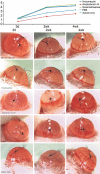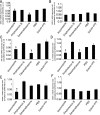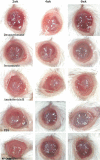Effect of itraconazole on the cornea in a murine suture model and penetrating keratoplasty model
- PMID: 29181306
- PMCID: PMC5686361
- DOI: 10.18240/ijo.2017.11.03
Effect of itraconazole on the cornea in a murine suture model and penetrating keratoplasty model
Abstract
Aim: To investigate the anti-(lymph)angiogenic and/or anti-inflammatory effect of itraconazole in a corneal suture model and penetrating keratoplasty (PK) model.
Methods: Graft survival, corneal neovascularization, and corneal lymphangiogenesis were compared among itraconazole, amphotericin B, dexamethasone, phosphate buffered saline (PBS) and surgery-only groups following subconjunctival injection in mice that underwent PK and corneal suture. Immunohistochemical staining and analysis were performed in each group. Real-time polymerase chain reaction (RT-PCR) was performed to quantify the expression of inflammatory cytokines (TNF-alpha, IL-6) and vascular endothelial growth factor (VEGF)-A, VEGF-C, VEGFR-2, and VEGFR-3.
Results: In the suture model, the itraconazole group showed less angiogenesis, less lymphangiogenesis, and less inflammatory infiltration than the PBS group (all P<0.05). The itraconazole group showed reduced expression of VEGF-A, VEGFR-2, TNF-alpha, IL-6 than the PBS group (all P<0.05). In PK model, the two-month graft survival rate was 28.57% in itraconazole group, 62.50% in dexamethasone group, 12.50% in PBS group, 0 in amphotericin B group and 0 in surgery-only group. Graft survival in the itraconazole group was higher than that in the amphotericin, PBS and surgery-only group (P=0.057, 0.096, 0.012, respectively). The itraconazole group showed less total angiogenesis and lymphangiogenesis than PBS group (all P<0.05).
Conclusion: Itraconazole decrease neovascularization, lymphangiogenesis, and inflammation in both a corneal suture model and PK model. Itraconazole has anti-(lymph)-angiogenic and anti-inflammatory effects in addition to its intrinsic antifungal effect and is therefore an alternative treatment option in cases where steroids cannot be used.
Keywords: amphotericin B; dexamethasone; graft survival; itraconazole; lymphangiogenesis; neovascularization.
Figures









Similar articles
-
Effect of sorafenib in a murine high risk penetrating keratoplasty model.Int J Ophthalmol. 2017 Jun 18;10(6):834-839. doi: 10.18240/ijo.2017.06.02. eCollection 2017. Int J Ophthalmol. 2017. PMID: 28730071 Free PMC article.
-
The Effect of 0.5% Timolol Maleate on Corneal(Lymph)Angiogenesis in a Murine Suture Model.J Ocul Pharmacol Ther. 2018 Jun;34(5):403-409. doi: 10.1089/jop.2017.0119. Epub 2018 May 14. J Ocul Pharmacol Ther. 2018. PMID: 29757062
-
Antiangiogenesis Effect of Albendazole on the Cornea.J Ocul Pharmacol Ther. 2019 May;35(4):254-261. doi: 10.1089/jop.2018.0103. Epub 2019 Apr 27. J Ocul Pharmacol Ther. 2019. PMID: 31033390
-
Immune reactions after modern lamellar (DALK, DSAEK, DMEK) versus conventional penetrating corneal transplantation.Prog Retin Eye Res. 2019 Nov;73:100768. doi: 10.1016/j.preteyeres.2019.07.001. Epub 2019 Jul 3. Prog Retin Eye Res. 2019. PMID: 31279005 Review.
-
Novel anti(lymph)angiogenic treatment strategies for corneal and ocular surface diseases.Prog Retin Eye Res. 2013 May;34:89-124. doi: 10.1016/j.preteyeres.2013.01.001. Epub 2013 Jan 22. Prog Retin Eye Res. 2013. PMID: 23348581 Review.
Cited by
-
Auricular erythermalgia showing excellent response to itraconazole: a case report.Ther Adv Chronic Dis. 2022 May 19;13:20406223221099335. doi: 10.1177/20406223221099335. eCollection 2022. Ther Adv Chronic Dis. 2022. PMID: 35620189 Free PMC article.
-
A cell-permeable peptide inhibitor of p55PIK signaling alleviates suture-induced corneal neovascularization and inflammation.Heliyon. 2023 Mar 31;9(4):e14869. doi: 10.1016/j.heliyon.2023.e14869. eCollection 2023 Apr. Heliyon. 2023. PMID: 37095989 Free PMC article.
-
The potential role of plant secondary metabolites on antifungal and immunomodulatory effect.Appl Microbiol Biotechnol. 2023 Jul;107(14):4471-4492. doi: 10.1007/s00253-023-12601-5. Epub 2023 Jun 5. Appl Microbiol Biotechnol. 2023. PMID: 37272939 Free PMC article. Review.
References
-
- Thomas PA. Fungal infections of the cornea. Eye (Lond) 2003;17(8):852–862. - PubMed
-
- Yavas GF, Ozturk F, Cusbeci T, Cetinkaya Z, Ermis SS, Kiraz N, Inan UU. Antifungal efficacy of voriconazole, itraconazole and amphotericin B in experimental fusarium solani keratitis. Graefes Arch Clin Exp Ophthalmol. 2008;246(2):275–279. - PubMed
-
- Lalitha P, Shapiro BL, Srinivasan M, Prajna NV, Acharya NR, Fothergill AW, Ruiz J, Chidambaram JD, Maxey KJ, Hong KC, McLeod SD, Lietman TM. Antimicrobial susceptibility of Fusarium, Aspergillus, and other filamentous fungi isolated from keratitis. Arch Ophthalmol. 2007;125(6):789–793. - PubMed
-
- Muller GG, Kara-Jose N, Silvestre de Castro R. Antifungals in eye infections: drugs and routes of administration. Rev Bras Oftalmol. 2013;72(2):132–141.
-
- Thomas PA, Kaliamurthy J. Mycotic keratitis: epidemiology, diagnosis and management. Clin Microbiol Infect. 2013;19(3):210–220. - PubMed
LinkOut - more resources
Full Text Sources
Other Literature Sources
Miscellaneous
